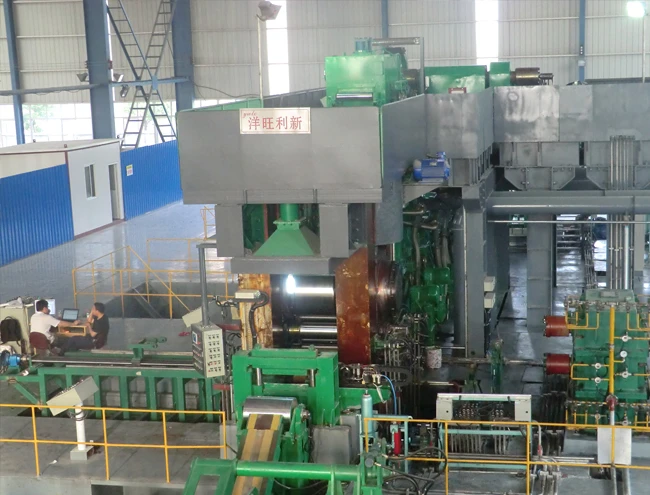
Why Choose Roll Bonding Cladding for Corrosion Control?
Cold-rolling the future: practical notes on roll-bonded cladding
I’ve walked more mills than I can remember, and—honestly—the moment you see a clean, single-pass bond line form, it’s hard not to grin. If you’re weighing roll bonding cladding for bimetal or trimetal strip, here’s the real-world picture from the shop floor to the boardroom.

Why this tech is trending
Markets are nudging hard toward lighter, cleaner, and cheaper. Electronics interconnects, decorative façades, chemical processing liners, and auto busbars keep asking for copper-on-steel, aluminum-on-steel, and even triple stacks without the headaches of explosive cladding or heavy hot rolling. To be frank, many customers say they’re done with soot, uneven surfaces, and environmental permits that take forever. The Cladding Rolling Mill from YWLX (Beijing—No.1518, LAR Valley Int'l, Guangwai Avenue, Xicheng District, 100055) leans on cold process control to deliver smooth clad strip up to 1000 mm wide and down to ≈0.2 mm—surprisingly thin for daily production.
Process flow—how the bond happens
Materials: copper/steel, aluminum/steel, copper/aluminum, aluminum/stainless, stainless/steel (bimetal or triple). Methods: coil prep (degrease, oxide brushing), stack/align, reduction schedule, primary bonding pass, optional intermediate anneal, finish reduction, tension levelling, slit/rewind. Typical QA: peel or shear at room temp, UT scanning, eddy-current at edges, tensile pull per ISO/ASTM, corrosion probe where needed. Standards customers ask for most often include ASTM A263/A264/A265 for clad plate acceptance and bond tests, tensile per ASTM E8/E8M or ISO 6892-1, and UT per ASTM A578/A578M. Service life? It depends—architectural panels often quote 15–25 years; heat-exchanger sheet in moderate chemistries can run a decade or more with routine passivation (real-world use may vary).
Product specs (typical)
| Product | Cladding Rolling Mill (YWLX) |
| Max coil width | ≈1000 mm |
| Min finished thickness | ≈0.2 mm (material/stack dependent) |
| Material combinations | Cu/Steel, Al/Steel, Cu/Al, Al/SS, SS/Steel; bi- or tri-metal |
| Line speed | ≈30–80 m/min (setup dependent) |
| Bond shear (indicative) | ≥70 MPa, often 90–120 MPa per pair and reduction |
| Surface quality | Ra ≤0.4 μm examples in FAT logs |
| Energy | ≈0.25–0.45 kWh/kg (process window) |
Vendor comparison (quick take)
| Option | Pros | Trade-offs |
|---|---|---|
| YWLX Cladding Rolling Mill | Cold process, thin gauges (≈0.2 mm), clean surface, continuous coil, bi/tri-metal | Needs tight surface prep; bond tuning by pair |
| Explosive cladding vendor | Good for thick plate, dissimilar extremes | Surface waviness, environmental permitting, not coil-based |
| Hot rolling retrofit | Established route for plate-sized runs | Higher energy, thicker product bias, larger capex |
Applications and field notes
- Electronics/busbars: Cu/Al or Cu/Steel saves cost while holding conductivity; customers report easier stamping and fewer burrs.
- Decor & architecture: Al/SS panels for corrosion resistance with nice finish—less polishing downstream.
- Chemical liners: SS/Steel or Al/Steel as diffusion/barrier layers; UT acceptance simplifies QA.
Mini case snippets: an EV connector shop switched to roll bonding cladding Cu/Al and cut raw metal costs ≈18% while meeting pull tests to ASTM E8. A mid-size heat-exchanger maker moved to Al/Steel with UT per ASTM A578; scrap fell by about a third—small, but it compounds.
Customization, QA, and documentation
Configurable brushing/degrease modules, reduction schedules, and inline UT/eddy-current are standard options. CE/ISO 9001 documentation support is available on request. For compliance-heavy buyers, YWLX maps mill tests to ASTM A263/A264/A265 bond checks and tensile per ISO 6892-1. It seems that even auditors like clean traceability.
Origin: No.1518, LAR Valley Int'l, Guangwai Avenue, Xicheng District, Beijing, 100055 • Product: Cladding Rolling Mill • Technology scope includes roll bonding cladding of Cu/Steel, Al/Steel, Cu/Al, Al/SS, SS/Steel (bi/tri-metal).
References
- ASTM A263 / A264 / A265 — Specifications for clad plate and bond testing.
- ASTM E8/E8M — Standard Test Methods for Tension Testing of Metallic Materials.
- ASTM A578/A578M — Standard Specification for Straight-Beam UT Examination of Rolled Steel Plates.
- ASM Handbook, Vol. 14A: Metalworking—Sheet Forming; sections on roll bonding fundamentals.
-
YWLX’s 1450mm Six-Hi Reversing Mill Goes Live in BangladeshNewsNov.24,2025
-
Adjusting Roll Gap in 6Hi Reversing Cold Rolling Mill for Thin StripNewsNov.13,2025
-
Quality Control Standards for Automatic Gauge Control in Strip RollingNewsNov.13,2025
-
Effect of Skin Pass Rolling on Metal DuctilityNewsNov.13,2025
-
Key Components of a Modern TempermillNewsNov.13,2025
-
Common Wear Patterns of Work Roll in Tandem Cold Mill OperationsNewsNov.13,2025
-
Revolutionary Skin Pass Rolling Technology for Enhanced Steel QualityNewsNov.04,2025










